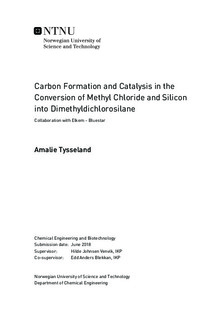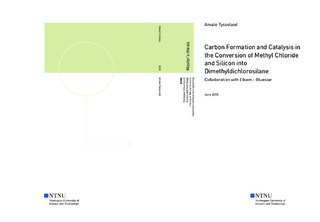| dc.description.abstract | The Direct Process is the most prominent method for producing dimethyldichlorosilane, and is a copper-catalyzed reaction between solid silicon and methyl-chloride gas. The process faces several complications such as the carbon formation during the synthesis, which causes both economical and efficiency problems. This thesis is part of a preliminary investigation into the carbon species which are formed in the Direct Process. Through research, starting with characterization of the contact mass (a mixture of silicon, copper and promoters), the aim is to better understand the process and gain more knowledge about the carbon formation. Reducing the carbon formation would increase the production efficiency as well as benefit the production economically.
In this thesis eight samples of reacted contact mass, as well as a reference sample of the same metallurgical silicon which is used to create the contact mass, were investigated. Raman Spectroscopy, Thermal gravimetric analysis, Scanning electron spectroscopy, X-ray diffraction, Energy-dispersive X-ray spectroscopy, Pyrolysis GC/MS and Fourier Transform Infrared Spectroscopy were used to characterize the samples of reacted contact mass and the reference sample of silicon.
Results from Raman Spectroscopy showed that much of the carbon was formed between 4 hours (sample P1) and 21.5 hours (sample P2) and that all the carbon displayed the D peak at 1300cm-1 and the G peak at 1600cm-1. The GC/MS indicated that a large range of organic components with long carbon chains are present within the samples. The organic content included alcohols, amides, acids, nitriles and esters. Several experiments showed oxygen within the samples. Thermal gravimetric analysis might be unsuited for the contact mass since there are indications that the silicon oxidizes during the analysis. Further work is needed to classify both the carbon species which are formed and from which reactions the carbon species stem from. An investigation with samples extracted at small intervals between 4 hours and 21.5 hours might prove especially useful. | |

